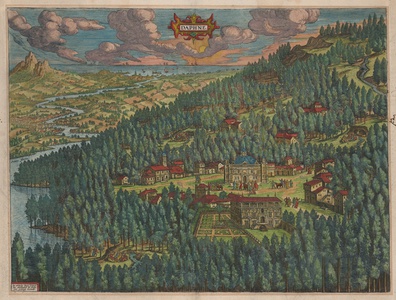| Method | Copper engraved with hand colour |
| Artist | Ortelius, Abraham |
| Published | Ex utriusque linguae scriptoribus adumbrabat Ab. Ortelius. Cum privilegio decennali. [1603] |
| Dimensions | 365 x 485 mm |
| Notes |
A romantic scene of the town of Daphne, a Seleucid settlement on the Turkish coast near Antioch, and a favourite resort town during the Roman era, from the 1603 Latin edition of Ortelius' famous Theatrum Orbis Terrarum. The view is ornamented in beautiful hand colour, with the heavily wooded climes of Daphne sloping down to the bends of the River Orontes, which meanders along the left hand side of the scene. The various bathhouses, pleasure palaces, and gardens of the town are dotted amongst the woods, depicted anachronistically in a grand Renaissance style. Groups of revellers lounge in wooded clearings, draw water from the fountains and streams, and congregate around a grand domed palace in the centre of the town. In the distance, the cities of Antioch and Seleucia can be seen, on the banks of the river as it makes its way to the Mediterranean beyond. The sun shines on the horizon, from behind a bank of gentle cloud. The scene is one of contentment and ease, despite Daphne's notorious reputation as a centre for wantonness, vice, and license of all kinds. The title, at top centre, is enclosed in a small decorative strapwork cartouche, while a simple box in the bottom left corner advertises Ortelius himself as the creator of the scene, 'sketched from the writings of authors both Greek and Latin.' The view, one of only two from the Parergon, was intended as a pair to Ortelius' scene of the vale of Tempe, an idyllic classical paradise bordered by Mount Olympus. The verso features a lengthy description in Latin, drawing upon Ammianus, Strabo, Tacitus, Philostratus, Petronius, and the Suda. This plate was also included in Ortelius' Parergon. The Parergon ('Supplement') was, as the title suggests, originally conceived of as a supplement to Ortelius' Theatrum. The work, a massive and intricately researched index of the classical world, was accompanied by a series of ancient world maps. Unlike the maps of the Theatrum, the majority of which were reductions of earlier maps, the maps of the Parergon were researched and drawn by Ortelius himself. The work was a huge commercial success, and the maps themselves set the standard for ancient world maps for the duration of the seventeenth century, being reproduced or reprinted by various publishers after Ortelius' final 1624 printing. His interest in the mapping of the ancient world is manifest. The maps of the Parergon are a veritable mine of textual commentary and classical philology, drawing upon Ptolemy, Strabo, Pliny, and many others. Interestingly, the project seems to have been a labour of love, rather than a mercantile venture. Ortelius himself was fascinated with the ancient world, and a formidable classical scholar in his own right. In addition to his work as a cartographer, he dealt in antiquities, visited and surveyed ancient sites across Europe, published a critical edition of Caesar's Gallic Wars in 1593, and assisted Welser in his studies of the famous Tabula Peutingeriana in 1598, producing an engraved copy of the map that can be found in later editions of the Parergon. Abraham Ortelius (1527 -1598) was a Flemish cartographer, cosmographer, geographer and publisher and a contemporary of Gerard Mercator, with whom he travelled through Italy and France. Although it is Mercator who first used the word "Atlas" as a name for a collection of maps, it is Ortelius who is remembered as the creator of the first modern atlas. Theatrum Orbis Terrarum was the first systematically collated set of maps by different map makers in a uniform format. Three Latin editions as well as a Dutch, French and German edition of Theatrum Orbis Terrarum were published by 1572 and a further 25 editions printed before Ortelius' death in 1598. Several more were subsequently printed until around 1612. Ortelius is said to have been the first person to pose the question of the continents once being a single land mass before separating into their current positions. Condition: Central vertical fold as issued. Toning to margins from previous mount. Manuscript ink markings and light staining to margins. Light diagonal creases to bottom of left side. Latin text on verso. |
| Framing | unmounted |
| Price | £1,000.00 |
| Stock ID | 52826 |

